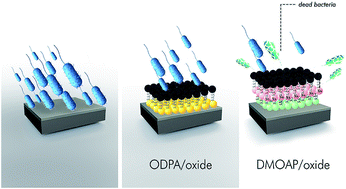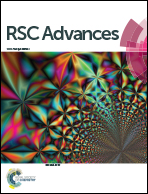New details of assembling bioactive films from dispersions of amphiphilic molecules on titania surfaces†
Abstract
Tailoring the surface properties of materials for biomedical applications is important to avoid clinical complications. Forming thin layers of amphiphilic molecules with apolar regions that facilitate attractive intermolecular interactions, can be a suitable and versatile approach to achieve hydrophobic surface modification and provide functional antibacterial properties. Aiming to correlate layer structure and properties starting from film formation, octadecylphosphonic acid (ODPA) and dimethyloctadecyl (3-trimethoxysilylpropyl) ammonium chloride (DMOAP) layers were adsorbed onto smooth titania surfaces. Then the films were studied by atomic force microscopy (AFM) and X-ray Photoelectron Spectroscopy (XPS), and their interactions with aqueous environments were characterized by contact angle and zeta potential measurements. In addition, antibacterial assays were performed using E. coli and S. mutants to reveal the antibacterial properties effected by the surface modification. Immediately after sputter deposition, titania was hydrophilic; however, after air storage and adsorption of DMOAP or ODPA, an increase in the water contact angle was observed. XPS investigations after layer formation and after antibacterial tests revealed that the attachment of layers assembled from ODPA on titania substrates is considerably stronger and more stable than that observed for DMOAP films. Heat treatment strongly affects DMOAP layers. Furthermore, DMOAP layers are not stable under biological conditions.



 Please wait while we load your content...
Please wait while we load your content...